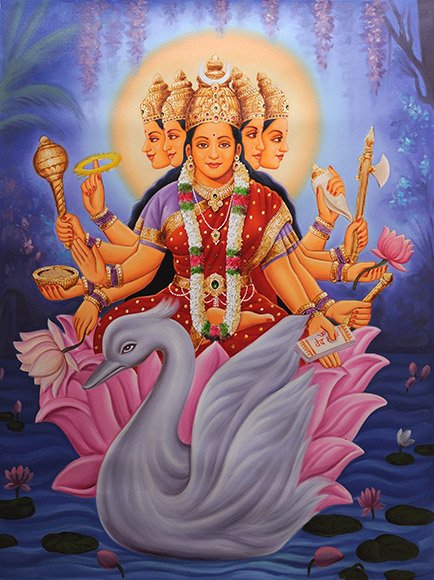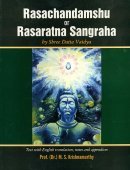Kacchapa, Kaccha-pa, Kācchapa: 21 definitions
Introduction:
Kacchapa means something in Buddhism, Pali, Hinduism, Sanskrit, the history of ancient India, Marathi, Hindi. If you want to know the exact meaning, history, etymology or English translation of this term then check out the descriptions on this page. Add your comment or reference to a book if you want to contribute to this summary article.
Alternative spellings of this word include Kachchhapa.
In Hinduism
Purana and Itihasa (epic history)
Source: archive.org: Shiva Purana - English Translation1) Kacchapa (कच्छप) refers to “tortoises”, according to the Śivapurāṇa 2.2.22. Accordingly as Śiva said to Sitā:—“[...] O my beloved, beautiful woman, clouds will not reach the place where I have to make an abode for you. [...] It [viz., the Himālayas] shines with ramparts of crystals, gold and silver. It is lustrous with the lakes—Mānasa and others. It abounds in buds and full-blown lotuses with golden stalks studded with gems. Crocodiles, sharks and tortoises (kacchapa) abound in the lakes”.
2) Kacchapa (कच्छप) refers to the “tortoise” which, together with Śeṣa (the serpent chief) is said to support the earth in turns on the hoods and the back respectively, according to the Śivapurāṇa 2.4.1 (“The dalliance of Śiva”).—Accordingly, after Lord Viṣṇu spoke to Brahmā: “After saying this, the lord of Lakṣmī immediately returned to his harem. O great sage, the gods too returned to their abodes along with me. On account of the dalliance of Śiva and Pārvatī, the earth quaked with the weight along with Śeṣa (the serpent) and Kacchapa (the tortoise). By the weight of Kacchapa, the cosmic air, the support of everything, was stunned and the three worlds became terrified and agitated. Then the gods along with me sought refuge in Viṣṇu and in our depression intimated to him the news”
Source: Cologne Digital Sanskrit Dictionaries: The Purana Index1a) Kacchapa (कच्छप).—A son of Viśvāmitra.*
- * Brahmāṇḍa-purāṇa III. 66. 69; Vāyu-purāṇa 91. 97; Viṣṇu-purāṇa IV. 7. 38.
1b) A Nāga.*
- * Vāyu-purāṇa 69. 73.
1c) One of the eight nidhis of Kubera.*
- * Vāyu-purāṇa 41. 10.
Kacchapa (कच्छप) refers to the “tortoises”, according to the Rāmāyaṇa verse 3.75.18. Accordingly:—“[...] then that Lord of People and Lord of Nature on exiting from that hermitage, he then came nigh of Lake Pampā along with Lakṣmaṇa. [...] That lake is beautified with packs of fishes and tortoises (kacchapa), and packs of trees on its banks, on which climber plants are wraparound like the ladyloves of those trees”.

The Purana (पुराण, purāṇas) refers to Sanskrit literature preserving ancient India’s vast cultural history, including historical legends, religious ceremonies, various arts and sciences. The eighteen mahapuranas total over 400,000 shlokas (metrical couplets) and date to at least several centuries BCE.
Chandas (prosody, study of Sanskrit metres)
Source: Shodhganga: a concise history of Sanskrit Chanda literatureKacchapa (कच्छप) refers to one of the 23 types of dohā metres (a part of mātrā type) described in the 1st chapter of the Vṛttamauktika by Candraśekhara (17th century): author of many metrical compositions and the son of Lakṣmīnātha Bhaṭṭa and Lopāmudrā.

Chandas (छन्दस्) refers to Sanskrit prosody and represents one of the six Vedangas (auxiliary disciplines belonging to the study of the Vedas). The science of prosody (chandas-shastra) focusses on the study of the poetic meters such as the commonly known twenty-six metres mentioned by Pingalas.
In Buddhism
Tibetan Buddhism (Vajrayana or tantric Buddhism)
Source: academia.edu: The Structure and Meanings of the Heruka MaṇḍalaKacchapa (कच्छप) is the name of a Vīra (hero) who, together with the Ḍākinī named Kacchapī forms one of the 36 pairs situated in the Jalacakra, according to the 10th century Ḍākārṇava chapter 15. Accordingly, the jalacakra refers to one of the three divisions of the saṃbhoga-puṭa (‘enjoyment layer’), situated in the Herukamaṇḍala. The 36 pairs of Ḍākinīs and Vīras [viz., Kacchapa] are white in color; the shapes of their faces are in accordance with their names; they have four arms; they hold a skull bowl, a skull staff, a small drum, and a knife..

Tibetan Buddhism includes schools such as Nyingma, Kadampa, Kagyu and Gelug. Their primary canon of literature is divided in two broad categories: The Kangyur, which consists of Buddha’s words, and the Tengyur, which includes commentaries from various sources. Esotericism and tantra techniques (vajrayāna) are collected indepently.
India history and geography
Source: Cologne Digital Sanskrit Dictionaries: Indian Epigraphical GlossaryKacchapa.—cf. sa-matsya-kacchapa (IE 8-5); tortoise; see jala- kara. Note: kacchapa is defined in the “Indian epigraphical glossary” as it can be found on ancient inscriptions commonly written in Sanskrit, Prakrit or Dravidian languages.

The history of India traces the identification of countries, villages, towns and other regions of India, as well as mythology, zoology, royal dynasties, rulers, tribes, local festivities and traditions and regional languages. Ancient India enjoyed religious freedom and encourages the path of Dharma, a concept common to Buddhism, Hinduism, and Jainism.
Languages of India and abroad
Pali-English dictionary
Source: BuddhaSasana: Concise Pali-English Dictionarykacchapa : (m.) a turtle; tortoise.
Source: Sutta: The Pali Text Society's Pali-English DictionaryKacchapa, (Sk. kacchapa, dial. fr. *kaśyapa, orig. Ep of kumma, like magga of paṭipadā) a tortoise, turtle S. IV, 177 (kummo kacchapo); in simile of the blind turtle (kāṇo k.) M. III, 169=S. V, 455; Th. 2, 500 (cp. J. P. T. S. 1907, 73, 174). -f. kacchapinī a female t. Miln. 67.

Pali is the language of the Tipiṭaka, which is the sacred canon of Theravāda Buddhism and contains much of the Buddha’s speech. Closeley related to Sanskrit, both languages are used interchangeably between religions.
Marathi-English dictionary
Source: DDSA: The Molesworth Marathi and English Dictionarykacchapa (कच्छप).—m (S) A tortoise or a turtle. 2 Used for kacch, as kacchapīṃ lāgaṇēṃ g. of o. To dangle after; to dance attendance or to be dependent upon;--used of persons: to fall unto; to become incumbent upon, grievous unto &c.;--used of things or matters.
Marathi is an Indo-European language having over 70 million native speakers people in (predominantly) Maharashtra India. Marathi, like many other Indo-Aryan languages, evolved from early forms of Prakrit, which itself is a subset of Sanskrit, one of the most ancient languages of the world.
Sanskrit dictionary
Source: DDSA: The practical Sanskrit-English dictionaryKācchapa (काच्छप).—a. Relating or belonging to a tortoise; कृत्वा वपुः काच्छपमद्भुतं महत् (kṛtvā vapuḥ kācchapamadbhutaṃ mahat) Bhāgavata 8.7.8.
--- OR ---
Kacchapa (कच्छप).—
-pī f.)
Derivable forms: kacchapaḥ (कच्छपः).
Kacchapa is a Sanskrit compound consisting of the terms kaccha and pa (प). See also (synonyms): kachapa.
Source: Cologne Digital Sanskrit Dictionaries: Edgerton Buddhist Hybrid Sanskrit DictionaryKacchapā (कच्छपा).—name of a river: Mahā-Māyūrī 253.3. In list of rivers, placed between Narmadā and Payoṣṇī.
Source: Cologne Digital Sanskrit Dictionaries: Shabda-Sagara Sanskrit-English DictionaryKacchapa (कच्छप).—m.
(-paḥ) 1. A turtle, a tortoise. 2. One of Kuvera'S Nid'his or treasures. 2. An attitude in wrestling. 4. A flat kind of still. f. (-pī) 1. A female tortoise, also a small one. 2. A kind of lute, also the lute of Saraswati. 3. A cutaneous disease, wart or blotch. E. kaccha a morass, and pa who cherishes, who inhabits watery places: the lute, &c. are so named from being similar in shape to the tortoise.
Source: Cologne Digital Sanskrit Dictionaries: Benfey Sanskrit-English DictionaryKacchapa (कच्छप).—[kaccha-pa] (vb. pā), m. 1. A tortoise, [Pañcatantra] 51, 13. 2. A proper name: a. of a Nāga, Mahābhārata 1, 4828; b. of a country, [Kathāsaritsāgara, (ed. Brockhaus.)] 18, 253.
Source: Cologne Digital Sanskrit Dictionaries: Cappeller Sanskrit-English DictionaryKacchapa (कच्छप).—[masculine] tortoise; [Name] of a serpent-demon.
Source: Cologne Digital Sanskrit Dictionaries: Monier-Williams Sanskrit-English Dictionary1) Kacchapa (कच्छप):—[=kaccha-pa] [from kaccha] m. ‘keeping or inhabiting a marsh’, a turtle, tortoise, [Mahābhārata; Gautama-dharma-śāstra; Manu-smṛti] etc.
2) [v.s. ...] a tumour on the palate, [Suśruta i, 306, 8]
3) [v.s. ...] an apparatus used in the distillation of spirituous liquor, a flat kind of still, [cf. Lexicographers, esp. such as amarasiṃha, halāyudha, hemacandra, etc.]
4) [v.s. ...] an attitude in wrestling, [cf. Lexicographers, esp. such as amarasiṃha, halāyudha, hemacandra, etc.]
5) [v.s. ...] Cedrela Toona, [cf. Lexicographers, esp. such as amarasiṃha, halāyudha, hemacandra, etc.]
6) [v.s. ...] one of the nine treasures of Kuvera, [cf. Lexicographers, esp. such as amarasiṃha, halāyudha, hemacandra, etc.]
7) [v.s. ...] Name of a Nāga, [Mahābhārata]
8) [v.s. ...] of a son of Viśvā-mitra, [Harivaṃśa]
9) [v.s. ...] of a country, [Kathāsaritsāgara]
10) Kācchapa (काच्छप):—mf(ī)n. ([from] kacchapa) relating or belonging to a tortoise.
Source: Cologne Digital Sanskrit Dictionaries: Yates Sanskrit-English Dictionary1) Kacchapa (कच्छप):—(paḥ) 1. m. A turtle. f. pī 3. f.
2) Kācchapa (काच्छप):—[(paḥ-pā-paṃ) a.] Of a tortoise,
Source: DDSA: Paia-sadda-mahannavo; a comprehensive Prakrit Hindi dictionary (S)Kacchapa (कच्छप) in the Sanskrit language is related to the Prakrit word: Kacchabha.
[Sanskrit to German]
Sanskrit, also spelled संस्कृतम् (saṃskṛtam), is an ancient language of India commonly seen as the grandmother of the Indo-European language family (even English!). Closely allied with Prakrit and Pali, Sanskrit is more exhaustive in both grammar and terms and has the most extensive collection of literature in the world, greatly surpassing its sister-languages Greek and Latin.
Hindi dictionary
Source: DDSA: A practical Hindi-English dictionaryKacchapa (कच्छप) [Also spelled kachchhap]:—(nm) tortoise, turtle; —[avatāra] the second incarnation of Lord Vishnu.
...
Kannada-English dictionary
Source: Alar: Kannada-English corpusKacchapa (ಕಚ್ಛಪ):—
1) [noun] any slow-moving plant-eating land reptile of the family Testudinidae, encased in a hard shell, into which it can retract its head and thick legs; a tortoise.
2) [noun] (myth.) one of the nine treasures of Kubēra, the Regent for wealth.
3) [noun] a container, with a long tube, in which liquor is distilled; a retort.
4) [noun] a disease of the palate.
Kannada is a Dravidian language (as opposed to the Indo-European language family) mainly spoken in the southwestern region of India.
See also (Relevant definitions)
Starts with: Kacchapa Jataka, Kacchapadesha, Kacchapaghata, Kacchapagiri, Kacchapaka, Kacchapalagirimahavihara, Kacchapalakkhana, Kacchapaloma, Kacchapam, Kacchapari, Kacchapasamsthana, Kacchapatika, Kacchapavine.
Ends with: Avatakacchapa, Bharukacchapa, Bimbakacchapa, Gajakacchapa, Girikacchapa, Grihakacchapa, Kanakacchapa, Kupakacchapa, Mamsakacchapa, Paippalikacchapa, Sa-matsya-kacchapa, Sakacchapa, Vikacchapa.
Full-text (+43): Grihakacchapa, Kakshapa, Girikacchapa, Kacchapadesha, Mamsakacchapa, Kaccakkatay, Avatakacchapa, Kacchapam, Kupakacchapa, Kacchapi, Kaccapam, Kaccan, Kashyapim Laganem, Kupakurma, Vikacchapa, Vallabhaka, Kupamanduka, Kupadardura, Kacchapaghata, Bahubhani Jataka.
Relevant text
Search found 30 books and stories containing Kacchapa, Kaccha-pa, Kācchapa, Kacchapā; (plurals include: Kacchapas, pas, Kācchapas, Kacchapās). You can also click to the full overview containing English textual excerpts. Below are direct links for the most relevant articles:
Garga Samhita (English) (by Danavir Goswami)
Verse 6.1.27 < [Chapter 1 - Jarāsandha’s Defeat]
Manusmriti with the Commentary of Medhatithi (by Ganganatha Jha)
Verse 1.44 < [Section XXV - The Viviparous, Oviparous, Sweat-born and Vegetable Beings]
Verse 1.45 < [Section XXV - The Viviparous, Oviparous, Sweat-born and Vegetable Beings]
The Mahavastu (great story) (by J. J. Jones)
Brihad Bhagavatamrita (commentary) (by Śrī Śrīmad Bhaktivedānta Nārāyana Gosvāmī Mahārāja)
Verse 2.4.142-144 < [Chapter 4 - Vaikuṇṭha (the spiritual world)]
Puranic encyclopaedia (by Vettam Mani)
The Shiva Purana (by J. L. Shastri)
Chapter 1 - The dalliance of Śiva < [Section 2.4 - Rudra-saṃhitā (4): Kumāra-khaṇḍa]
Related products
